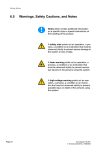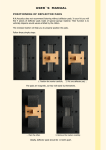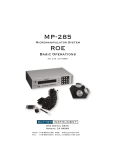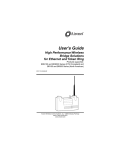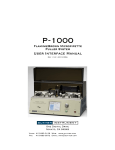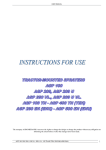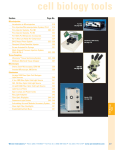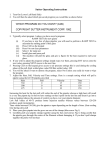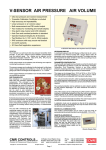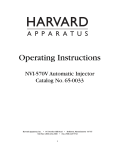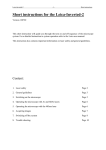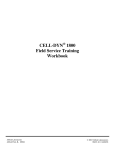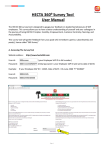Download User Manual - Spectra Services
Transcript
OPERATION MANUAL Rev. 4.13 (20100914) XenoWorks™ Digital Microinjector XenoWorks™ Digital Microinjector Operation Manual (Rev. 4.13 ( (20100914)) Sutter Instrument Company One Digital Drive Novato, CA 94949 Voice: 415-883-0128 Web: www.sutter.com Fax: 415-883-0572 Email: [email protected] II Q Copyright © 2009 Sutter Instrument Company. All Rights Reserved. XenoWorks is a trademark of Sutter Instrument Company. XENOWORKS DIGITAL MICROINJECTOR OPERATION MANUAL – REV. 4.13 ( (20100914) III TABLE OF CONTENTS 1. GENERAL INFORMATION..............................................................................................................1 1.1 ABOUT THIS MANUAL .......................................................................................................................1 1.2 TECHNICAL SUPPORT ........................................................................................................................1 2. SAFETY WARNINGS AND PRECAUTIONS .................................................................................1 2.1 ELECTRICAL .......................................................................................................................................1 2.2 PRECAUTIONS ....................................................................................................................................2 3. PRODUCT DESCRIPTION ...............................................................................................................3 3.1 PACKING LIST ....................................................................................................................................3 3.2 INSTRUMENT DESIGN........................................................................................................................4 3.3 IDENTIFICATION OF INSTRUMENT COMPONENTS AND CONTROLS ...............................................4 3.3.1 Drierite Canister ........................................................................................................................5 3.4 CONTROLS AND FEATURES ...............................................................................................................6 3.4.1 Hold Port.....................................................................................................................................6 3.4.2 Inject/Transfer Port ...................................................................................................................6 3.4.3 Range Setting for Transfer and Compensation Pressures....................................................6 3.4.4 Hold Key......................................................................................................................................7 3.4.5 Hold Dial .....................................................................................................................................7 3.4.6 Hold Display................................................................................................................................7 3.4.7 Pulse/Continuous Injection Mode Key.....................................................................................7 3.4.8 Pressure/Pulse Width Dial ........................................................................................................8 3.4.9 Pressure/Pulse Width Display ..................................................................................................8 3.4.10 Pressure/Pulse Width Key ......................................................................................................8 3.4.11 Clear Key...................................................................................................................................8 3.4.12 Inject Key ..................................................................................................................................8 3.4.13 Transfer Dial ............................................................................................................................8 3.4.14 Transfer Display.......................................................................................................................8 4. INSTALLATION .................................................................................................................................9 5. OPERATING INSTRUCTIONS......................................................................................................11 5.1 THE HOLD FUNCTION .....................................................................................................................11 5.2 THE TRANSFER FUNCTION .............................................................................................................12 5.2.1 Transfer Channel and Settings ..............................................................................................12 5.2.3 Performance Advice .................................................................................................................13 5.3 THE INJECT FUNCTION ...................................................................................................................14 5.3.1 Setting up the High Pressure Injection Channel and Micropipette...................................14 5.3.2 Continuous Mode .....................................................................................................................14 5.3.3 Pulse Mode................................................................................................................................14 6. TROUBLESHOOTING ....................................................................................................................17 6.1 INSTRUMENT POWER ......................................................................................................................17 6.2 HOLD FUNCTION .............................................................................................................................17 6.3 TRANSFER FUNCTION .....................................................................................................................18 XENOWORKS DIGITAL MICROINJECTOR OPERATION MANUAL – REV. 4.13 ( (20100914) IV 6.4 INJECT FUNCTION ...........................................................................................................................19 6.5 GENERAL ..........................................................................................................................................19 7. MAINTENANCE...............................................................................................................................21 7.1 REGENERATION OF THE DRIERITE DESICCANT ............................................................................21 7.2 FITTING NEW O-RINGS....................................................................................................................22 APPENDIX A. SPARE PARTS............................................................................................................23 APPENDIX B. PRESSURE CONVERSION ......................................................................................25 APPENDIX C. FUSE REPLACEMENT.............................................................................................27 REPLACEMENT FUSE RATINGS:............................................................................................................27 APPENDIX D. TRANSPORTING THE MICROINJECTOR...........................................................29 APPENDIX E. SPECIFICATIONS .....................................................................................................31 APPENDIX F. DRIERITE MATERIAL SAFETY DATA SHEET ...................................................33 APPENDIX G. LIMITED WARRANTY..............................................................................................35 APPENDIX H. DISCLAIMER .............................................................................................................37 INDEX ....................................................................................................................................................39 TABLE OF FIGURES Figure 3-1. Components of the XenoWorks Digital Microinjector........................................................ 3 Figure 3-2. Controller/Compressor features (front view)....................................................................... 5 Figure 3-3. Controller/Compressor features (rear view). ....................................................................... 5 Figure 3-4. Remote User Interface`. ....................................................................................................... 7 Figure 4-1. Connecting the micropipette holder to the pressure tubing.............................................. 9 Figure 4-2. Attaching the pressure fitting to other end of pressure tubing.......................................10 Figure 7-1. Connecting the micropipette holder to the pressure tubing............................................22 TABLE OF TABLES Table 2-1. Mains fuse type and ratings. .................................................................................................. 1 XENOWORKS DIGITAL MICROINJECTOR OPERATION MANUAL – REV. 4.13 ( (20100914) V Table 3-1. Pressure/Vacuum range settings. ........................................................................................... 6 Table 5-1. Continuous mode actions and controls. ...............................................................................14 Table 5-2. Pulse mode actions and controls...........................................................................................15 Table B-1. Pressure/Vacuum range settings. ........................................................................................25 Table C-1. Mains fuse type and ratings.................................................................................................27 XENOWORKS DIGITAL MICROINJECTOR OPERATION MANUAL – REV. 4.13 ( (20100914) 1 1. GENERAL INFORMATION 1.1 About This Manual The XenoWorks Digital Injector is a injection system comprised of three basic parts: the controller/compressor, injection tubing, and the user interface (remote and foot switch). In the next, few pages you will find a product description to help you become acquainted with the parts, followed by installation instructions, and then detailed operating instructions. Please take the time to read these instructions to assure the safe and proper use of this instrument. 1.2 Technical Support Unlimited technical support is provided by Sutter Instrument Company at no charge to our customers. Our technical support staff is available between the hours of 8:00 AM and 5:00 PM (Pacific Time) at (415) 883-0128. You may also E-mail your queries to [email protected]. XENOWORKS DIGITAL MICROINJECTOR OPERATION MANUAL – REV. 4.13 ( (20100914) 1 2. SAFETY WARNINGS AND PRECAUTIONS Please read this manual carefully before operating the instrument. 2.1 Electrical Use only a properly grounded power source and power cord; both appropriately rated for use with this instrument. Before operating the instrument, check that the instrument’s voltage rating corresponds to the supply voltage. The voltage rating can be found on the power entry module on the rear of the instrument. Before making electrical connections, ensure that the instrument is switched off. Replace fuse only with the same type and rating as indicated in the following table. Table 2-1. Mains fuse type and ratings. Mains Power Source Mains Voltage Setting 110 VAC “110” (100 – 120 VAC) 4A, 250V “220” (200 – 240 VAC) 2A, 250V 220 VAC Fuse (Type: Time Delay, 5mm x 20mm, glass tube) Fuse Rating Manufacturer Examples Bussmann: GMC-4A, GMC-4-R (RoHS), GDC-4A, or S506-4A (RoHS) Littelfuse: 239 004, 239.004.P (RoHS), 218.004, or 218.004.P (RoHS) Bussmann: GDC-2A or S506-2A (RoHS) Littelfuse: 239 002 or 239.002.P (RoHS) A spare fuse is provided with fuse holder located in the power input module. Please refer to “Appendix C - Fuse Replacement” for instructions on how to change the fuse. To prevent fire or shock hazard do not expose the unit to rain or moisture. To avoid electrical shock and exposure to hazardous electrical voltages: • Do not disassemble the unit. Refer servicing to qualified personnel. • Always use the grounded power supply cord provided to connect the unit to a grounded outlet (3-prong). This is required to protect you from injury in the event that an electrical hazard develops. To comply with FDA and CE electromagnetic immunity and interference standards; and to reduce the electromagnetic coupling between this and other equipment in your lab always use the types and lengths of interconnect cables provided with the unit for the interconnection of the remote user interface and foot switch. XENOWORKS DIGITAL MICROINJECTOR OPERATION MANUAL – REV. 4.13 ( (20100914) 2 2.2 Precautions Failure to comply with any of the following precautions may damage this device. Please read this manual carefully before operating the instrument. Use this instrument only for microinjection purposes in conjunction with the procedures and guidelines in this manual. Do not operate if there is any obvious damage to any part of the instrument. Do not operate this instrument near flammable materials. Do not obstruct the side vents or cooling fan intakes. As with all microinjection devices, sharp micropipettes can fly out of their holder unexpectedly. Always take precautions to prevent this from happening. Never loosen the micropipette holder chuck when the tubing is pressurized, and never point micropipettes at yourself or others. Always wear safety glasses when using sharp glass micropipettes with pressure microinjectors. This instrument is designed for use with capillary glass micropipettes with an outer diameter of 1mm. For glass with outer diameters of 1.2 and 1.5 mm, please contact Sutter Instrument to order an additional holder. Adapters for other capillary diameters are available upon request. Use this instrument only for microinjection purposes in conjunction with the procedures and guidelines in this manual. Please retain the original packaging for future transport of the instrument. Some applications, such as piezo-impact microinjection call for the use of mercury in the micropipette tip. The use of any hazardous materials with any XenoWorks instrument is not recommended and undertaken at the users’ own risk. Always transport the instrument in its original packaging, and install shipping plate screws before shipping. This instrument contains no user-serviceable components — do not open the instrument casing. This instrument should be serviced and repaired only by Sutter Instrument or an authorized Sutter Instrument servicing agent. This device is intended only for research purposes. Sutter Instrument reserves the right to change specifications without prior notice. XENOWORKS DIGITAL MICROINJECTOR OPERATION MANUAL – REV. 4.13 ( (20100914) 3 3. PRODUCT DESCRIPTION 3.1 Packing List The XenoWorks™ Digital Microinjector is shipped with the following components. If any items are missing or damaged, contact Sutter Instrument immediately. 1. 2. 3. 4. 5. 6. Digital Microinjector cabinet (controller/compressor) Digital Microinjector control box (remote user interface) Cable to connect remote user interface with controller. Foot switch Micropipette holder (2) Tubing kits (2), each including 2.5 m (8 ft) clear ETFE tubing, pressure fitting, 5 spare ferrules 7. Power cord 8. Instruction Manual Figure 3-1. Components of the XenoWorks Digital Microinjector. XENOWORKS DIGITAL MICROINJECTOR OPERATION MANUAL – REV. 4.13 ( (20100914) 4 3.2 Instrument Design The XenoWorks Digital Microinjector is a pneumatic pressure control system for single-cell microinjection and manipulation. Two independently controlled pressure channels are available: Hold and Inject/Transfer. The Hold Channel is designed to create negative and positive pressure sufficient to gently hold and release a single cell, usually a mammalian oocyte, zygote or early embryo (including fully hatched blastocyst stage embryos), against a hollow, fire-polished glass micropipette. Ascidian, amphibian and insect embryos can be immobilized in a similar fashion, depending upon their physical characteristics and the type of micropipette used. The Inject/Transfer Channel provides negative and positive pressures required to aspirate single cells (such as embryonic stem cells) into an appropriately fashioned micropipette in preparation for transfer to another location (such as the blastocyst of an early mammalian embryo). The transfer of cells is achieved by reversing the pressure in the transfer micropipette and gently injecting. There are four range settings available for the Transfer/Compensation channel, allowing for the fine-tuning of the pressure range for a given application. In addition to these low positive and negative pressures, the Inject/Transfer Channel is capable of providing the high positive pressure required to inject solutions through very narrow (typically less than one micron) injection micropipettes (during, for example, the injection of DNA solution into the pronucleus of a mammalian “2PN” stage zygote). Users should refer to later sections of this manual for more information on specific microinjection applications, and to the application note “Introduction to Microinjection” available from Sutter upon request, or for download from http://www.sutter.com. 3.3 Identification of Instrument Components and Controls The following figures illustrate the features on the front and rear of the controller/compressor and the controls on the remote user interface . XENOWORKS DIGITAL MICROINJECTOR OPERATION MANUAL – REV. 4.13 ( (20100914) 5 Figure 3-2. Controller/Compressor features (front view). Figure 3-3. Controller/Compressor features (rear view). 3.3.1 Drierite Canister The XenoWorks Digital Microinjector incorporates an integral compressor, which takes its air supply from the ambient air. The canister of Drierite granules dries the air before it is compressed, to ensure a minimum of condensation and a long working life for the compressor components. The blue Drierite granules slowly turn pink as they absorb moisture from the input air. Once all the granules have turned pink, the Drierite should be desiccated or replaced (described in the Maintenance chapter later in this manual). The approximate life of the Drierite canister is one year under normal conditions. XENOWORKS DIGITAL MICROINJECTOR OPERATION MANUAL – REV. 4.13 ( (20100914) 6 3.4 Controls and Features 3.4.1 Hold Port This port supplies a pressure range from –350 hPa to +350 hPa (± 7 hPa) and is typically used to control the pressure in the holding micropipette. The pressure can be varied using the Hold Dial on the remote user interface. 3.4.2 Inject/Transfer Port This port supplies four possible transfer/compensation ranges. Range setting 1 is the default setting, providing from –175 hPa to +175 hPa (± 7hPa), and is typically used to control the pressure in the transfer micropipette during embryonic stem cell transfer experiments, and to create a compensation pressure for high-pressure injection of solutions. The compensation pressure can be varied using the Transfer Dial on the user interface module. The pressure pulse duration for pronuclear and adherent cell injection can be set with the Pressure Pulse Width dial. 3.4.3 Range Setting for Transfer and Compensation Pressures This rotary switch is used to set the compensation pressure range on the Inject/Transfer port. The following table shows the compensation pressure range for each of the four settings. Table 3-1. Pressure/Vacuum range settings. Range Setting Scale Pressure Applications 1 Unit/Transfer Dial (approx.) Range psi hPa hPa psi 1 Low +2.5 to -2.5 +172 to -172 1 0.015 2 Medium +5 to -5 +345 to -345 2 0.03 3 MediumHigh +10 to -7 +689 to 483 4 0.06 4 High +15 to -7 +1034 to 483 8 0.12 Standard setting for ES Cell, Pronuclear Injection, and Adherent Cell microinjection Used when higher compensation pressures are needed for smaller volumes back-loaded into injection needle Used for front-loading pipette with very small volumes (femtoliters) and to create higher compensation pressures for these small volumes. XENOWORKS DIGITAL MICROINJECTOR OPERATION MANUAL – REV. 4.13 ( (20100914) 7 Figure 3-4. Remote User Interface`. 3.4.4 Hold Key This key is used to toggle the Hold pressure on and off. In the OFF position, no pressure is applied to the Hold Port. In the ON position, the pressure, in hPa, shown in the Hold LED Display (above the Hold Dial) is applied to the Hold Port. 3.4.5 Hold Dial Controls the pressure delivered to the Hold Port when the Hold Key is in the ON position. The range is, continuous from –350 hPa to +350 hPa (± 7 hPa). 3.4.6 Hold Display Displays the pressure delivered to the Hold Channel (in hPa). 3.4.7 Pulse/Continuous Injection Mode Key This key toggles between the pulse mode and continuous mode used for high-pressure injections. The pulse pressure and duration are set with the Pressure/Pulse Width Dial. The continuous pressure is active as long as the Inject Key or footswitch is held down. The mode selected and active is indicated with a green LED. XENOWORKS DIGITAL MICROINJECTOR OPERATION MANUAL – REV. 4.13 ( (20100914) 8 3.4.8 Pressure/Pulse Width Dial This dial is used to adjust the pressure and duration of injection. Injection pressure can be adjusted from 0 to 5600 (± 50 hPa) in 70 hPa increments. Pulse duration can be adjusted from 0.01 to 10 seconds in 0.01-second increments. 3.4.9 Pressure/Pulse Width Display This display indicates either the injection pressure (in hPa) or the injection duration (in seconds) when in Pulse Mode. Toggling between these two values is accomplished with the Pressure/Pulse Width Key. 3.4.10 Pressure/Pulse Width Key This key is used to toggle the Pressure/Pulse Width Dial/Display between “Pressure” and “Pulse Width”. 3.4.11 Clear Key Applies maximum pressure to the right hand (Inject/Transfer) channel and is used to clear blockages of the micropipette. When the key is pressed and held down, the pressure applied increases from zero to maximum pressure (80 psi). CAUTION: THE CLEARING FUNCTION SHOULD NOT BE USED WITH MICROPIPETTES THAT HAVE TIP INNER DIAMETERS GREATER THAN APPROXIMATELY ONE (1) MICRON. 3.4.12 Inject Key This key applies the pressure (set by the center Pressure/Pulse Width Dial) to the Inject/Transfer pressure port. When the instrument is in Pulse Mode, the duration of the pressure will be for the time set by the Pulse Width Dial. When the instrument is in Continuous Mode, the pressure is applied for as long as the Inject Key (or footswitch) is held down. 3.4.13 Transfer Dial This dial controls the pressure continuously supplied to the Inject/Transfer Port. Range Setting 1 (standard setting) provides –175 hPa to +175 hPa (± 7 hPa) of pressure. 3.4.14 Transfer Display This display indicates the low pressure being constantly delivered to the Transfer Channel (in hPa). XENOWORKS DIGITAL MICROINJECTOR OPERATION MANUAL – REV. 4.13 ( (20100914) 9 4. INSTALLATION NOTE: These instructions refer to the use of the XenoWorks Digital Microinjector with the XenoWorks Micromanipulator. While the Digital Microinjector is supplied with micropipette holders that are compatible with a number of different micromanipulators, the setup procedure used with those micromanipulators may vary slightly. 1. Unpack the XenoWorks Digital Microinjector. 2. Remove the (4) shipping screws and plate from the right side of the instrument. (Retain plate & screws for possible future transport.) 3. Connect the microinjector compressor and user interface modules using the cable provided. 4. Place the compressor module on a flat, solid surface, away from the microscope (on a different surface from microscope’s is strongly suggested). 5. Ensure that the compressor is located close enough to the microscope that the pressure lines will reach without placing any strain on the micropipette holders or micromanipulators. The user interface module can be located conveniently next to the microscope. 6. Remove the micropipette holders from their cases and connect them to the free end of the pressure tubing as shown below. Figure 4-1. Connecting the micropipette holder to the pressure tubing. XENOWORKS DIGITAL MICROINJECTOR OPERATION MANUAL – REV. 4.13 ( (20100914) 10 9. Attach a pressure fitting to the other end of the pressure tubing as shown in below. Do not use tools to tighten pressure fittings since damage may result. Figure 4-2. Attaching the pressure fitting to other end of pressure tubing. 10. Connect each of the pressure lines to the appropriate ports of the compressor module. You will hear a “click” sound as the fittings engage in the port. 11. Connect the power cord to the power input module on the rear of the compressor and a mains power outlet. The XenoWorks Digital Microinjector is now set up and ready for use. XENOWORKS DIGITAL MICROINJECTOR OPERATION MANUAL – REV. 4.13 ( (20100914) 11 5. OPERATING INSTRUCTIONS 5.1 The Hold Function If injecting adherent cells, or if no Hold Function is required, skip this section and move on to the Transfer Function. The left hand rotary control and its associated LED display correspond to the pressure control of the left-hand port on the front of the compressor module, and of any tubing, micropipette holder and micropipette attached to that port. The pressure delivered by this port ranges from -350 hPa to 350 hPa (± 7hPa), and is designed to allow a typical holding micropipette to hold a mammalian oocyte, blastocyst or zygote, for example. The Hold Function can be used in a similar fashion to that of a traditional micrometer-type air microinjector, by “dialing” the pressure up or down to release or hold the cell in place. A setting of +20 – 30 will advance the meniscus to the top and reducing the pressure to +10 will being to draw in the cell or egg. Setting up the holding channel and micropipette: 1. First, ensure that the Hold Function is switched off (the default position of the Hold Function after first powering up the unit), then check that the tubing and fitting are properly engaged in the Hold Channel port, (the left hand port on the front of the compressor module) and that all fittings are finger-tight. 2. Fit the holding micropipette into the micropipette holder by loosening the clear plastic chuck ¼ turn, gently inserting the micropipette, and tightening the chuck until the micropipette cannot be moved in or out of the holder. CAUTION: Do not over tighten the chuck; doing so could crush the O-rings and prevent them from making a airtight seal around the base of the micropipette. Take care not to force the micropipette into a holder. If the micropipette will not easily slide in, it is because either the chuck is locked down, or there is an obstruction such as broken glass in the holder. Care should be taken to ensure the back end of the micropipette is clean and free of cracks or breakages to avoid damage to the O-rings. Despite these precautions, the O-rings will eventually wear, and they should be inspected from time to time and replaced when necessary. 3. Once the micropipette is fitted into the holder, the holder can be locked into the micropipette holder clamp on the micromanipulator drive module and the tip of the micropipette lowered into the injection chamber. Caution: Take care not to let the holder “snap” into the spring-loaded clamp, since this may cause damage to the micropipette tip. Turn the Hold Port on and dial the hold pressure up to +20 – 30. This will prevent oil or media from drawing into the pipette. 4. When the micropipette is lowered into the medium, a small quantity of medium will be aspirated by capillary action into the tip. It is unnecessary to aspirate any more medium than this. 5. With the Hold Pressure Dial set at approximately zero, switch the Hold Function on. The holding channel is now ready to use. XENOWORKS DIGITAL MICROINJECTOR OPERATION MANUAL – REV. 4.13 ( (20100914) 12 6. Under certain conditions (such as a broken micropipette), it can become possible to aspirate fluid from the injection chamber, through the tubing and into the compressor module through the front port. Particular care should be taken not to allow this to occur. To safeguard against this event, a fluid sensor has been installed inside the controller. If fluid is drawn into the controller, the fluid sensor will be activated and a compensating positive pressure will turn onto expel the fluid. The positive pressure will stay on continuously even if you power off and on the injector. To avoid getting aspirating fluid into the controller: a. Making sure that the micropipettes are removed from the injection chamber when it is left unattended, by, for example, using the micromanipulator’s Home Function. b. Switch off the Hold Pressure Port and turn the Transfer pressure to zero when the device is to be left unattended. If fluid has been inadvertently aspirated into the Hold Port tubing, it can be purged by connecting the Hold Port to the Inject/Transfer Port. Then pressing the ‘Clear’ key. Fluid in the Hold Port tubing can also be purged by turning the Hold Dial to maximum positive pressure until the fluid is drained. Never leave the unit unattended when there is fluid in the tubing. If this happens, contact Sutter Instrument for tech support and instructions on how to resolve this matter. 5.2 The Transfer Function The Transfer Function works in a similar manner to the Hold Function, but is always active – there is no on/off control. Pressure ranges from -175 hPa to 175 hPa (± 7 hPa) (Range 1), and is applied to the pressure port used to control the pressure in the transfer/inject micropipette. A typical application for which this function might be used includes the transfer of embryonic stem cells into a blastocyst. Caution: Do not shut down and restart the device with a micropipette immersed in the dish, since during the device’s initialization process, a small amount of pressure is sometimes released. 5.2.1 Transfer Channel and Settings 1. As with the holding channel, all fittings should be tight and fully engaged, and the transfer micropipette inserted into the holder with care. Remember not to tighten the chuck too far or the O-rings will be crushed. 2. Insert the micropipette holder into the clamp on the micromanipulator. Take care not to let the holder “snap” into the spring-loaded clamp, since damage may occur to the micropipette tip. 3. Adjust the micropipette holder, by sliding it up or down the clamp, so that the tip of the micropipette projects into the optical axis of the microscope. For details on aligning micropipettes, please refer to the instruction manual of the micromanipulator. If using a micropipette with a bend, rotate the holder in the clamp until the bend section is parallel to the bottom of the injecting chamber. 4. Turn the Transfer Pressure Dial +80 and lower the micropipette into the injection medium. XENOWORKS DIGITAL MICROINJECTOR OPERATION MANUAL – REV. 4.13 ( (20100914) 13 5. A small amount of medium will be drawn into the micropipette by capillary action. Wait approximately 30 seconds for the pressure to equalize, and then slowly turn the Transfer Dial clockwise until the meniscus between air and medium is less than approximately 2 mm from the micropipette tip. The Transfer Dial should read between +060 to +090 at this point. 6. The micropipette can now be loaded with, for example, embryonic stem cells by placing the tip close to the material to be aspirated and slowly turning the Transfer Dial counterclockwise to lower settings (e.g., between +30 - +70). 7. Expelling cells from the micropipette is achieved by gently turning the dial clockwise, in much the same way as with a standard micrometer microinjector. 5.2.3 Performance Advice The XenoWorks Digital Microinjector uses precision-regulated air pressure to hold, inject and manipulate cells and other tissue samples. The best control is attained when the interface (meniscus) between the air in the micropipette and the medium in the dish is as close as possible to the tip of the micropipette. The optimum position of the meniscus will depend upon a number of factors including the type, size and diameter of the micropipette, the viscosity of the medium and the depth of the injecting chamber. In general, though, the closer to the micropipette tip the meniscus can be brought, the better the control over the pressure. During the course of an experiment, it may be necessary to ensure that the meniscus has not been allowed to be pulled too far up inside the micropipette. If the meniscus is too close to the micropipette tip, control can become too sensitive, and will not be smooth. This is particularly so with embryonic stem cell transfer micropipettes. If this is the case, simply draw a little more medium into the micropipette by turning the Transfer Dial counter-clockwise. CAUTION: Care should be taken not to apply too much positive pressure to the micropipette; as with any other microinjection device, it is possible to purge all the medium from the micropipette and stream bubbles into the injection chamber, which may damage tissues and obscure the microscope optics. NOTE: The pressure reading on the LED display is a guide only; it is possible to maintain embryonic stem cells stationary in the transfer micropipette tip, yet still show a positive pressure in the display. The display is showing only the pressure supplied to the micropipette, even though the pressure effects observed at the micropipette tip are a combination of pressure supplied by the injector and capillary forces. CAUTION: Under certain conditions (such as a broken micropipette), it can become possible to aspirate fluid from the injection chamber, through the tubing and into the compressor module through the front port. Particular care should be taken not to allow this to happen, since the compressor module could be damaged. Safeguard against such damage by: 1. Making sure that the micropipettes are removed from the injection chamber when it is left unattended (by using the micromanipulator’s Home Function, for example). 2. Switch off the Hold Pressure Port and turn the Transfer pressure to zero when the device is to be left unattended. XENOWORKS DIGITAL MICROINJECTOR OPERATION MANUAL – REV. 4.13 ( (20100914) 14 Fluid that has been inadvertently aspirated into the Inject/Transfer tubing can be purged by pressing the Clear Key (ensure there is no micropipette in the holder before doing this). Never leave the unit unattended when there is fluid in the tubing. 5.3 The Inject Function 5.3.1 Setting up the High Pressure Injection Channel and Micropipette If the digital microinjector is being used for the high pressure injection of solutions (such as DNA, RNA, proteins etc.) into cells through narrow microinjection micropipettes (tip sizes less than 1 micron), the Transfer Function should be used as an adjustable positive pressure (“base” pressure) applied to the tip of the injection micropipette. This ensures that there is a gentle, constant flow of solution from the micropipette, preventing dilution of the solution to be injected by the medium in the injection chamber. The base pressure also minimizes, to some degree, blockage of the micropipette tip by foreign objects in the surrounding medium. The wider the tip of the injection micropipette, the less base pressure is required. As a rule, start at 5 hPa and increase slowly until a gentle stream of material can be seen coming from the tip. Under certain microscope optics, this stream is easily visible as a “Schlieren” pattern resulting from the different densities of injected solution and surrounding medium. Once the stream can be seen issuing from the micropipette tip, reduce the base pressure until the stream almost disappears. Two modes of high-pressure injection are available to suit different users’ preferences: 5.3.2 Continuous Mode High pressure of a predetermined value is applied for as long as the Inject Key or the footswitch is held down. This mode is useful when injecting a field of cultured adherent cells, where long durations and/or high pressures will rupture and kill the cells. The pressure can be set low, and the duration short to deliver tiny, discrete and reproducible volumes to each cell. Table 5-1. Continuous mode actions and controls. Action Adjust compensation pressure Select continuous injection mode Select high-pressure adjustment Adjust high-pressure value Inject Control Used Transfer dial Pulse/Cont. key to "Cont." Pressure/Pulse Width key to "Pressure Pressure/Pulse Width dial Inject key or footswitch 5.3.3 Pulse Mode Pulse Mode provides high-pressure injection by discrete pulses of a given pressure (in hPa) for a predetermined amount of time. Pressure is applied for a predetermined duration no matter how long the Inject Key or footswitch is pressed. This mode is useful for the injection of DNA into the pronucleus of a mammalian zygote for example, where successful injection XENOWORKS DIGITAL MICROINJECTOR OPERATION MANUAL – REV. 4.13 ( (20100914) 15 requires a high pressure and a slight inflating (approximate doubling in size) of the pronucleus can be seen. Table 5-2. Pulse mode actions and controls. Action Adjust compensation pressure Select pulse injection mode Select high-pressure adjustment Adjust high-pressure value Select injection duration adjustment Adjust injection duration Inject Control Used Transfer dial Pulse/Cont. key to "Pulse" Pressure/Pulse Width key to "Pressure" Pressure/Pulse Width dial Pressure/Pulse Width key to "Pulse Width" Pressure/Pulse Width dial Inject key or footswitch Once the base pressure, injection pressure and, if used, injection duration have been set, the system is ready to begin injection. Consult the application note “Introduction to Microinjection” for more information on microinjection techniques. XENOWORKS DIGITAL MICROINJECTOR OPERATION MANUAL – REV. 4.13 ( (20100914) 17 6. TROUBLESHOOTING 6.1 Instrument Power Problem Cause Solution The instrument does not activate when the power is switched on. 1. The power cord is not connected to an appropriate supply. Connect the power cord to the mains supply. Be sure that the power rating is matched to the requirements of the instrument. Catalog number BRE110 requires 100-110v AC, BRE220 requires 220-240v AC. Replace the fuse and check that the power supply is appropriate to the requirements of the device. Connect the user interface module to the compressor module using the cable provided. 2. The protection fuse has blown. 3. The user interface module is not properly connected. 6.2 Hold Function Problem Cause Solution The holding pressure is insufficient to hold a cell, or the “hold” control seems unresponsive. 1. The holding pressure is not activated. 2. The tubing is not connected to the holding pressure port. Activate the holding pressure with the Hold on/off switch (green LED will light). Connect the tubing to the left hand (holding) port. There will be a positive click when the fitting is engaged. Check the tubing for kinks, holes and other damage and replace if necessary (order part # BR-DT). Tighten all fittings. Replace ferrules. Slowly rotate the Hold control clockwise, until the air/medium meniscus is as close to the tip as possible. Note that it is possible to create an effective holding pressure and still show a positive value in the Hold LED display. Carefully tighten the pipette holder’s plastic tip. Carefully tighten the rod holder’s black parts located behind the plastic tip. 3. There is a leak in the tubing, or the pressure fittings are loose. 4. The air/medium interface is too far inside the micropipette tip. 5. The plastic tip of the pipette holder is not tightened down. 6. The black parts on the rod holder behind the plastic tip are loose. XENOWORKS DIGITAL MICROINJECTOR OPERATION MANUAL – REV. 4.13 ( (20100914) 18 6.3 Transfer Function Problem Cause Solution The Transfer pressure control seems unresponsive. 1. The tubing is not connected to the transfer pressure port. Connect the tubing to the right hand (inject/transfer) port. There will be a positive click when the fitting is engaged. Check the tubing for kinks, holes and other damage and replace if necessary (order part # BR-DT). Tighten all fittings. Replace ferrules. Slowly rotate the Transfer control clockwise, until the air/medium meniscus is as close to the tip as possible. Carefully tighten the pipette holder’s plastic tip. Carefully tighten the rod holder’s black parts located behind the plastic tip. 2. There is a leak in the tubing, or the fittings are loose. 3. The air/medium interface is too far inside the micropipette tip. 4. The plastic tip of the pipette holder is not tightened down. 5. The black parts on the rod holder behind the plastic tip are loose. Note that the Transfer LED display is a guide only and that it is possible to have a fully equalized micropipette (no net in- or out-flow of material), and still show a positive or a negative (i.e., non-zero) value in the display. If, after performing the above checks, the device is still unresponsive, please contact your Sutter Instrument distributor for assistance. The Transfer display shows a positive or negative pressure, yet the cells are stationary inside micropipette. 1. Factors such as viscosity of medium and capillary/surface tension forces create a negative pressure in the micropipette. It may take slight POSITIVE pressure from the microinjector to balance this action and even with a net negative pressure at the tip, the pressure applied to the tool may be slightly positive. If the Transfer pressure can be dialed up or down with no effect on the aspirated cells, there may be a problem with the pressure hose connection (see “The Transfer pressure control seems unresponsive”, above). 2. Tubing connector not plugged in all the way into the port on the front panel of the digital injector. 3. Plastic tip of the pipette holder is not tightened down. This is normal. Use the display pressure value as a guide only. Make sure that the tubing connector is plugged in all the way into the port. Carefully tighten the pipette holder’s plastic tip. XENOWORKS DIGITAL MICROINJECTOR OPERATION MANUAL – REV. 4.13 ( (20100914) 19 6.4 Inject Function Problem Cause Solution There is no material flowing from the tip of the micropipette, even when positive pressure is applied (80 psi; 5566 hPa on display). 1. The microscope optics are unable to resolve the stream Switch to suitable optics, if available. Brightfield illumination will be unlikely to resolve the stream, unless the injected solution is colored. Phase contrast will be more effective and Nomarski and Hofmann better still. A constant stream can also be detected by moving the micropipette tip close to a freely floating cell and trying to “blow it away”. Press the Clear Key a number of times, holding the key down longer each time until the blockage is cleared. If this does not clear the blockage, the pipette should be replaced. 2. The micropipette is blocked. CAUTION: Some residual pressure may remain in the tubing. Take great care to point the micropipette in a safe direction when removing it from the holder. 6.5 General Problem Cause Solution Compressor motor runs continuously for more than five minutes when the instrument is on, but not being used. 1. There is a leak in one of the pressure lines. Check each pressure line for kinks or holes. Replace lines if necessary - order part # BR-DT. Push the pressure fitting into its port until a click is felt. If no tubing is fitted to a port, check that the port is closed by pressing the release tab on top of the port. All pressure fittings should be finger tight - no tools are necessary to tighten pressure fittings. Insert a micropipette into the holder. If no micropipettes are being used, switch the Hold pressure off and turn the Transfer pressure down to zero. 2. The pressure fitting has not been fully engaged in the pressure port on the front of the compressor module. 3. There is a loose pressure fitting. 4. There is no micropipette in the holder. If, after performing the above checks, the compressor motor continues to run for longer than five minutes, shut the instrument down and contact your Sutter distributor. The compressor is loud when activated. The shipping plate and screws on the right side panel have not been removed. Turn off the compressor. Place the cabinet on its left side (front side up) and remove the hex-head screws and shipping plate. XENOWORKS DIGITAL MICROINJECTOR OPERATION MANUAL – REV. 4.13 ( (20100914) 20 Problem Cause Solution NOTE: To replace the shipping plate before storage or shipping, place the cabinet on its side again so that the receiving holes inside on the compressor line up with the external holes. “ERR” appears on all B displays of the remote user interface. 1. There is an electronic short on the circuit board. 2. There is a constant/continuous positive pressure and the compressor is always on. It is possible that the solution is down all the way all the way into the tubing and into the compressor. If this has happened, the fluid sensor has been activated/triggered inside the injector to create continuous positive pressure with protectant fluid used to protect the compressor from water damage. Contact Sutter Instrument. Contact Sutter Instrument. XENOWORKS DIGITAL MICROINJECTOR OPERATION MANUAL – REV. 4.13 ( (20100914) 21 7. MAINTENANCE 7.1 Regeneration of the Drierite Desiccant The XenoWorks™ Digital Microinjector needs no routine maintenance except for periodic replacement or “regeneration” of the Drierite desiccant. The indicating Drierite, found in the canister on the rear of the microinjector, is a desiccant made of calcium sulfate (97%) and cobalt chloride (3%). Drierite is non-toxic and can be handled with few precautions. This material is used to remove water vapor from the air intake of the system. As it absorbs more moisture, it becomes pink in color and must eventually be “regenerated” (dried) or replaced with new indicating desiccant canister. New canisters are available from Sutter (order part number X870700), or the existing granules can be regenerated by following these instructions. 1. Turn off the device and unplug the power cord. To remove the canister from the device, pull off the output (left) air tube from the white plastic connector on the canister. 2. The two black plastic hold-downs that secure the canister to the rear panel can be released by forcing one half of the connector out of the other half at the point where they meet. Remove the canister and unscrew the plastic end cap, being careful not to lose the black rubber-sealing ring that forms the airtight seal within the cap. 3. With the cap off, remove the spring, the perforated aluminum plate and the first filter and second filter. The far aluminum plate can be kept in place. Pour the Drierite out onto a glass or metal tray, spreading it evenly, one granule deep, and heat it for one hour at 200°C. Pre-dry both filters at 100°C for 30 minutes just prior to assembly. 4. Before refilling the canister, the Drierite granules should be cooled in an airtight container. After cooling, replace the Drierite granules, keeper, and filters into the canister in the order they were removed. 5. First, install the filter against the keeper that was left in the canister. 6. If this keeper was removed, slide it in first ensuring that it lays flat against the plastic shoulders at the far end of the canister. With the far keeper and filter in place, pour in the new or regenerated Drierite. 7. Next, insert the second filter followed by the keeper and the spring. 8. Check that the rubber seal is in the proper position and, if you wish, apply a thin layer of vacuum grease on to the rubber seal to ensure a tight fit. There is no need to over-tighten the cap, but a good seal is needed to prevent air leaks. 9. Reinstall the canister on the injector, with the air tube connections to the top. 10. Slide the black plastic hold-downs inside one another and squeeze them together to firmly hold the canister in place. 11. At this point, re-connect the air-output tube (the one which enters into the rear panel of the injector). CAUTION: Failure to maintain the Drierite may result in impaired instrument performance and can damage the instrument. XENOWORKS DIGITAL MICROINJECTOR OPERATION MANUAL – REV. 4.13 ( (20100914) 22 7.2 Fitting New O-rings Routine use will create wear on the three black O-rings located in the tip of the micropipette holder chuck. Occasionally, the O-rings will need to be replaced. To do this, gently remove the old O-rings with an appropriate tool (a bent paper clip, for example). Discard the old Orings and insert three new ones, taking care to ensure that they are flat against the back of the chuck. The new O-rings can be pushed down inside the chuck by gently screwing the chuck onto the knurled black aluminum pressure fitting. Take care not to damage the chuck during this procedure. Figure 7-1. Connecting the micropipette holder to the pressure tubing. XENOWORKS DIGITAL MICROINJECTOR OPERATION MANUAL – REV. 4.13 ( (20100914) 23 APPENDIX A. SPARE PARTS BR-MH Micropipette holder, includes micropipette holder body, 9 O-rings BR-DT Digital tubing kit, includes 2 x 2 m ETFE tubing, pressure fitting, 6 ferrules X870700 Drierite canister XENOWORKS DIGITAL MICROINJECTOR OPERATION MANUAL – REV. 4.13 ( (20100914) 25 APPENDIX B. PRESSURE CONVERSION XenoWorks Digital Microinjector displays pressure in hecta-Pascals (hPa). The following conversion factors should be used for other pressure units: 1 hPa = 100 Pascals (Pa) 1 Pascal = 0.01 hPa 1 hPa = 1 millibars 1 millibar = 1 hPa 1 hPa = .001 bars 1 bar = 1000 hPa 1 hPa = 0.0145 psi 1 psi = 68.9655 hPa Table B-1. Pressure/Vacuum range settings. Range Setting Scale Pressure Applications 1 Unit/Transfer Dial (approx.) Range psi hPa hPa psi 1 Low +2.5 to -2.5 +172 to -172 1 0.015 2 Medium +5 to -5 +345 to -345 2 0.03 3 MediumHigh +10 to -7 +689 to 483 4 0.06 4 High +15 to -7 +1034 to 483 8 0.12 Standard setting for ICSI, NT, ES Cell, Pronuclear Injection, and Adherent Cell microinjection Used when higher compensation pressures are needed for smaller volumes back-loaded into injection needle Used for font-loading pipette with very small volumes (femtoliters) and to create higher compensation pressures for these small volumes. XENOWORKS DIGITAL MICROINJECTOR OPERATION MANUAL – REV. 4.13 ( (20100914) 27 APPENDIX C. FUSE REPLACEMENT In the event that the instrument fails to power up when it is switched on, the line power fuses should be checked to determine whether they have blown. The fuses are located in the fuse holder in the power entry module on the rear of the control module. To replace a fuse, first unplug the power cord from the power entry module, revealing the fuse holder below. Remove the fuse holder. Note that both fuses in the fuse holder are used simultaneously. Either one or both may have blown. Discard the blown fuse(s). Insert appropriately rated replacement fuses (see below). Replace the fuse holder in the power entry module and reconnect the power cord. Replacement Fuse Ratings: Table C-1. Mains fuse type and ratings. Mains Power Source Mains Voltage Setting 110 VAC “110” (100 – 120 VAC) 4A, 250V “220” (200 – 240 VAC) 2A, 250V 220 VAC Fuse (Type: Time Delay, 5mm x 20mm, glass tube) Fuse Rating Manufacturer Examples Bussmann: GMC-4A, GMC-4-R (RoHS), GDC-4A, or S506-4A (RoHS) Littelfuse: 239 004, 239.004.P (RoHS), 218.004, or 218.004.P (RoHS) Bussmann: GDC-2A or S506-2A (RoHS) Littelfuse: 239 002 or 239.002.P (RoHS) XENOWORKS DIGITAL MICROINJECTOR OPERATION MANUAL – REV. 4.13 ( (20100914) 29 APPENDIX D. TRANSPORTING THE MICROINJECTOR When transporting, use the original packaging and the supplied shipping screws and shipping plate. If the packaging and shipping screws have been misplaced, contact your local Sutter distributor. Install the four shipping screws and the shipping plate to the right side of the compressor module using the following procedure: 1. Align shipping plate holes with holes in the right side of the instrument. 2. Mount the shipping plate using the four 10-32 socket-head shipping screws provided by placing screws first through plate, then through instrument side panel and finally engaging screws into interval motor bracket. 3. Slowly advance the shipping screws in evenly to secure the compressor before storage or shipping. 4. Tighten the (4) shipping screws using a 5/32" allen wrench. 5. The controller/compressor is now ready for transport, and can be placed into the original foam packaging for shipping. CAUTION: Do not transport the compressor module without using the provided shipping screws and plate or instrument damage may result. If screws and plate are misplaced and unavailable, please contact Sutter Instrument to obtain the proper hardware. XENOWORKS DIGITAL MICROINJECTOR OPERATION MANUAL – REV. 4.13 ( (20100914) 31 APPENDIX E. SPECIFICATIONS Q Pressure channels 2, independently controllable Maximum pressure 5600 hPa (+/- 50 hPa) High pressure 0 to 5600 hPa (+/- 50 hPa) in 7 hPa increments Injection time 0.01 to 10 seconds in 0.01 sec increments Inject activation Transient; hand or foot switch Transfer pressure -175 to +175 hPa (+/- 7 hPa) in 7 hPa increments Hold pressure -350 to +350 hPa (+/- 7 hPa) in 7 hPa increments Clear function Ramp from Inject value to maximum pressure Display 3 x 7-segment LED Controls Tactile keys, rotary optical encoders Tubing 2 m ETFE Micropipette holder diameter 4 mm Micropipette compatibility 1 mm capillary glass* other sizes available upon request Piezo-impact drive compatibility Prime Tech, Burleigh Storage Environment Temperature: Humidity: 0 – 70°C (32 – 158°F) 0 – 95% (non-condensing) Operating Environment Temperature: Humidity: 3.5 – 35°C (38.3 – 95°F) 0 – 80% (non-condensing) (80% @ 31°C (87.8°F), decreasing linearly to 67% @ 35°C (95°F)) Regulatory Safety: EMC: EN61010-1, TUV, CE EN61326, TUV, CE XENOWORKS DIGITAL MICROINJECTOR OPERATION MANUAL – REV. 4.13 ( (20100914) 32 Cleaning 70% alcohol (or e.g. UV) Dimensions (H x W x D) Compressor module - 407 x 440 x 150 mm (16 x 17 x 6 inches) User interface module - 164 x 123 x 70 mm (6.5 x 4.8 x 2.8 inches) Weight Controller/compressor: Remote user interface: Electrical: Mains voltage Power consumption Power cord Mains fuse (rear of cabinet) Input power (BRE110) Input power (BRE220) 1504 g (3.36 lb (3 lb, 5 oz)) 42 g (0.093 lb (1.48 oz)) 100 - 240 V, 50/60 H 440W 10A, 250V, with safety ground plug Time delay (or time lag) 5 x 20 mm glass tube. 100–120 VAC (±10%), 50/60 Hz Fuse rating: 4.0 A. Power: 450 VA 220–240 VAC (± 10%), 50/60 Hz Fuse rating: 2.0 A. Power: 280 VA For manufacturer examples, refer to Table C-1 Mains fuse type and ratings. XENOWORKS DIGITAL MICROINJECTOR OPERATION MANUAL – REV. 4.13 ( (20100914) 33 APPENDIX F. DRIERITE MATERIAL SAFETY DATA SHEET IDENTITY: INDICATING DRIERITE DESCRIPTION: 1/16" TO 1/4" BLUE GRANULES DATE PREPARED 1-3-96 SECTION I MANUFACTURER’S NAME: ADDRESS: EMERGENCY PHONE NUMBER: INFORMATION PHONE NUMBER: W.A. HAMMOND DRIERITE CO. LTD. P.0. BOX 460, 138 DAYTON AVE., XENIA, OH 45385 (513) 376-2927 (513) 376-2927 SECTION II INGREDIENTS CHEMICAL IDENTITY % OSHA PEL ACGIH TLV UNITS C.A.S. # 7778-18-9 CALCIUM SULFATE 97 15 10 mg/M3 COBALT CHLORIDE 3 0.05* 0.05* mg/M3 7646-79-9 *(AS COBALT METAL) HAZARDOUS MATERIALS IDENTIFICATION SYSTEM (HMIS) HEALTH FLAMMABILITY REACTIVITY PROTECTIVE EQUIPMENT 1 0 1 E SECTION III PHYSICAL/CHEMICAL CHARACTERISTICS SPECIFIC GRAVITY:(H20=1): SOLUBILITY IN WATER: MELTING POINT: APPEARANCE: 1.87 0.25 GRAMS PER LITER 1450° C DECOMPOSES BLUE GRANULES; NO ODOR SECTION IV FIRE AND EXPLOSION HAZARD DATA FLASH POINT: EXTINGUISHING MEDIA: SPECIAL FIREFIGHTING PROCEDURES: UNUSUAL FIRE AND EXPLOSION HAZARDS: NONE NOT COMBUSTIBLE NONE NONE SECTION V REACTIVITY DATA STABILITY: INCOMPATIBILITY (MATERIALS TO AVOID): HAZARDOUS DECOMPOSITION BYPRODUCTS: HAZARDOUS POLYMERIZATION: STABLE STRONG ACIDS Cl2 @ 318°C; SO3 @ 1450°C WILL NOT OCCUR SECTION VI HEALTH HAZARD DATA EYES: PARTICLES MAY CAUSE IRRITATION. SKIN: THIS MATERIAL IS NOT TOXIC. MAY DRY OR IRRITATE SKIN INHALATION: MAY CAUSE AN IRRITATION OF RESPIRATORY ORGANS OF SENSITIVE PERSONS RESULTING IN THE OBSTRUCTION OF AIRWAYS WITH SHORTNESS OF BREATH. INGESTION: MAY CAUSE VOMITING, DIARRHEA AND SENSATION OF WARMTH SIGNS AND SYMPTOMS OF OVER EXPOSURE: EYE, NOSE, THROAT, OR RESPIRATORY IRRITATION XENOWORKS DIGITAL MICROINJECTOR OPERATION MANUAL – REV. 4.13 ( (20100914) 34 CARCINOGENICITY OF INGREDIENTS: MATERIAL IARC NTP OSHA CALCIUM SULFATE NOT LISTED NOT LISTED NOT LISTED COBALT CHLORIDE YES* NO NO *(COBALT & COBALT COMPOUNDS ARE CLASSIFIED AS GROUP 2B) MEDICAL CONDITIONS GENERALLY AGGRAVATED BY EXPOSURE: PRE-EXISTING UPPER RESPIRATORY AND LUNG DISEASE SUCH AS, BUT NOT LIMITED TO, BRONCHITIS, EMPHYSEMA & ASTHMA EMERGENCY AND FIRST AID PROCEDURES: EYES: FLUSH WITH WATER DUST INHALATION: REMOVE TO FRESH AIR SKIN: WASH WITH WATER INGESTION: NONE KNOWN SECTION VII SPILL OR LEAK PROCEDURES STEPS TO BE TAKEN IN CASE MATERIAL IS RELEASED OR SPILLED: SWEEP OR VACUUM MATERIAL INTO APPROPRIATE WASTE CONTAINER FOR DISPOSAL. AVOID DUSTING CONDITIONS. WASTE DISPOSAL METHOD: THIS MATERIAL CAN BE DISPOSED OF AS AN INERT SOLID WASTE IN AN APPROVED LAND FILL OR BY OTHER PROCEDURES ACCEPTABLE UNDER FEDERAL, STATE AND LOCAL REGULATIONS. PRECAUTIONS TO BE TAKEN IN HANDLING AND ST0RING: KEEP CONTAINER CLOSED STORE IN A COOL DRY PLACE AVOID GENERATING DUST SECTION VIII CONTROL MEASURES RESPIRATORY PROTECTION: NIOSH/OSHA APPROVED FOR DUST VENTILATION: TO MEET TLV REQUIREMENTS EYES: SAFETY GLASSES OR GOGGLES OTHER PROTECTIVE EQUIPMENT: GLOVES OR PROTECTIVE CLOTHING ARE NOT USUALLY NECESSARY BUT MAY BE DESIRABLE IN SPECIFIC WORK SITUATIONS. SECTION IX • REFERENCES U.S. DEPARTMENT OF LABOR – OSHA FORM APPROVED OMB NO.1218 -0072. OSHA HAZARD COMMUNICATION STANDARD 29 CFR 1910.1200 U. S. GYPSUM CO. Although the information and recommendation set forth herein are presented in good faith and believed to be correct as of the date hereof, the W.A. Hammond DRIERITE Co. makes no representation as to the completeness or accuracy thereof. Information is supplied upon the condition that the person receiving same will make their own determination as to its suitability for their purpose prior to use. In no event will the W.A. Hammond DRIERITE Co. be responsible for damages of any nature whatsoever resulting from the use of or reliance upon information herein supplied. No representations or warranties, either expressed or implied, of merchantability, fitness for a particular purpose of or any other nature are made hereunder with respect to information or the product to which information refers. XENOWORKS DIGITAL MICROINJECTOR OPERATION MANUAL – REV. 4.13 ( (20100914) 35 APPENDIX G. LIMITED WARRANTY Sutter Instrument Company, a division of Sutter Instrument Corporation, limits the warranty on this instrument to repair or replacement of defective components for one year after the date of shipment, provided the instrument has been operated in accordance with the instructions outlined in the instruction manual. Abuse, misuse or unauthorized repairs will void this warranty. Limited warranty work will be performed only at the factory, and the cost of shipment both ways is to be borne by the user. The limited warranty is as stated above and no implied or inferred liability for direct or consequential damages is intended. XENOWORKS DIGITAL MICROINJECTOR OPERATION MANUAL – REV. 4.13 ( (20100914) 37 APPENDIX H. DISCLAIMER The XenoWorks Digital Microinjector (Models BRE110 and BRE220) should only be used in a laboratory environment for use on animal tissues. It is not intended for use, nor should be used, in human experimentation, or applied to humans in any way. This is not a medical device. Do not open or attempt to repair the instrument without expressed and explicit instructions from Sutter Instrument Company. Extreme heat and high voltages are present and could cause injury. Do not allow unauthorized and or untrained operatives to use this device. Any misuse will be the sole responsibility of the user/owner and Sutter Instruments assumes no implied or inferred liability for direct or consequential damages from this instrument if it is operated or used in any way other than for which it is designed. XENOWORKS DIGITAL MICROINJECTOR OPERATION MANUAL – REV. 4.13 ( (20100914) 39 INDEX A I allen wrench.......................................................... 29 Inject activation .................................................... 31 Inject Function................................................ 14, 19 Inject/Transfer Port ................................................6 Injection time ........................................................ 31 Input power (BRE110)......................................... 32 Input power (BRE220)......................................... 32 INSTALLATION.....................................................9 Instrument Design ..................................................4 C Cleaning................................................................. 32 Clear function ....................................................... 31 Clear Key..................................................................8 compressor ............................................................ 10 compressor module.......9, 10, 11, 12, 13, 17, 19, 29 Continuous Mode.............................................. 8, 14 control box................................................................3 controller/compressor..............................................4 controller/compressor........................................... 29 Controller/Compressor............................................3 Controls ..................................................... 4, 6, 7, 31 D Dimensions............................................................ 32 disclaimer .............................................................. 37 Display ........................................................... 7, 8, 31 Drierite ........................................................ 5, 21, 23 Drierite Canister......................................................5 drierite material safety data sheet ...................... 33 E ETFE tubing..................................................... 3, 23 F Features....................................................................6 Foot switch...............................................................3 Fuse Replacement ................................................ 27 fuses, replacement mains.....................................................................1 G General Safety Information....................................1 H hecta-Pascals......................................................... 25 High pressure.................................................. 14, 31 Hold Channel ........................................................ 11 Hold Dial ..................................................................7 Hold Display.............................................................7 Hold Function................................................. 11, 17 Hold Key...................................................................7 Hold Port..................................................................6 Hold pressure........................................................ 31 M mains fuses ......................................................................1 Maximum pressure............................................... 31 Micropipette compatibility................................... 31 Micropipette holder .................................... 3, 23, 31 Micropipette holder diameter.............................. 31 mounting screws................................................... 29 O Operating Environment ...................................... 31 OPERATING INSTRUCTIONS ........................ 11 P packaging............................................................... 29 Packing List .............................................................3 Piezo-impact drive compatibility......................... 31 Power cord................................................................3 precautions...............................................................2 operation...............................................................2 Pressure channels................................................. 31 Pressure Conversion ............................................ 25 Pressure/Pulse Width Display................................8 Pressure/Pulse Width Key......................................8 PRODUCT DESCRIPTION ..................................3 Pulse Mode........................................................ 8, 14 Pulse/Continuous Injection Mode Key ..................7 R Regulatory............................................................. 31 remote user interface ......................................... 3, 4 S safety warnings........................................................1 shipping ............................................................. 9, 29 shipping plate........................................................ 29 shipping screws..................................................... 29 Spare Parts............................................................ 23 Specifications ........................................................ 31 XENOWORKS DIGITAL MICROINJECTOR OPERATION MANUAL – REV. 4.13 ( (20100914) 40 Storage Environment........................................... 31 T technical specifications electrical............................................................. 32 mains fuse...................................................... 32 mains voltage ................................................ 32 power consumption ...................................... 32 power cord ..................................................... 32 technical support .....................................................1 Transfer Display ......................................................8 Transfer Function .................................... 11, 12, 18 Transfer pressure ................................................. 31 transporting .......................................................... 29 Transporting the Microinjector........................... 29 TROUBLESHOOTING....................................... 17 Tubing ............................................................... 3, 31 U user interface module................................... 6, 9, 17 W warranty................................................................ 35 Weight.................................................................... 32 XENOWORKS DIGITAL MICROINJECTOR OPERATION MANUAL – REV. 4.13 ( (20100914)


















































